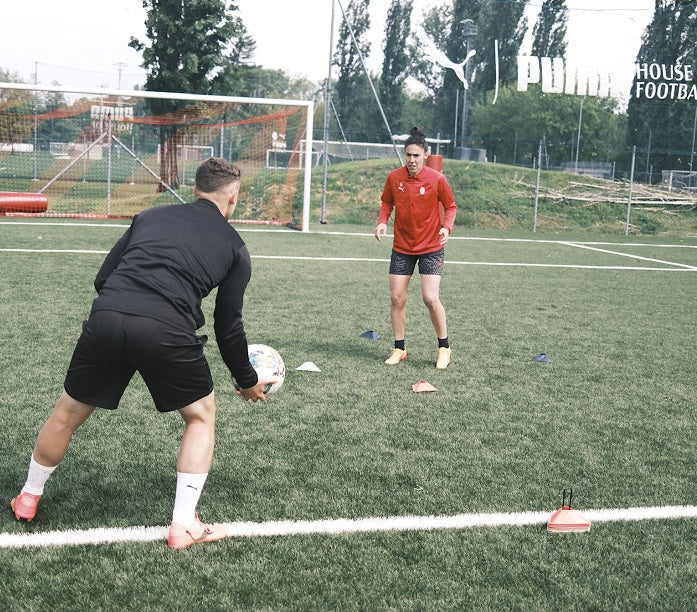Football is a team sport, but individual training plays a crucial role in personal development and long-term success on the pitch. For players who want to work specifically on their skills, training away from the team is particularly valuable. This article explains in detail how to train for football alone and which training content is particularly effective.
Why train alone?
Training alone offers numerous advantages. On the one hand, you can work specifically on your individual strengths and weaknesses. On the other hand, you are more flexible and can design the training according to your own needs. Whether it's technique, speed or strength - with individual training you determine the focus.
Requirements for effective individual training
1. Planning and goal setting
Before you start training, you should set clear goals. Do you want to improve your technique, work on your endurance or specifically address your weaknesses? A well-thought-out training plan will help you work efficiently and in a structured manner. If you need help with planning, you can use 360Football's online training program, #LevelUpYourGame . It offers a variety of exercises and training plans that you can do on your own.
2. The right equipment
You don't need a lot of equipment for effective training. A soccer ball and a few cones are enough. If you want to intensify your training, you can use aids such as rebounders or Blazepods . 360Football also offers you individual advice to help you find the right equipment for your training.
3. Training environment
Choose a suitable training location. A sports field, an open space or even your garden can serve as a training area. Make sure that the surface is level and the area is large enough to be able to carry out your exercises safely.
Which training content makes sense?
1. Technique training
Technique is the foundation of football. A good feel for the ball, precise passes and clean ball control are crucial. The following exercises are recommended for technique training:
- Dribbling: Place cones at different distances and dribble through the course at different speeds and directions.
- Ball control: Use a rebounder or wall to make passes and receive the rebounding ball with different parts of your body.
- Shooting practice: Shoot at a goal or a marked area from different distances. Pay attention to precision and technique.
On the 360Football YouTube channel you will find numerous videos that will help you to perform these exercises correctly. For example, watch the video "Training for wingers - whole session alone".
2. Speed and agility
Speed and agility are crucial factors for success in modern football. The following exercises are particularly suitable for individual training:
- Sprint exercises: Set markers 10 to 30 meters apart and perform short, explosive sprints with at least 30 seconds rest per 10m sprint distance.
- Change of direction: Practice quick changes of direction with a ball to improve your agility and maneuverability.
360Football offers detailed instructions for these exercises on its YouTube channel, such as in the video "Technique Training - 10 Top Exercises for Kids".
3. Strength training
Physical fitness is another important aspect of football. Strength training helps you prevent injuries and improve your performance. Here are a few basic exercises:
- Squats: This exercise strengthens your thigh and glute muscles. You can do it with your own body weight or with additional weights.
- Lunges: They train your leg and buttock muscles and improve your stability.
- Core training: A strong core is essential for balance and stability. Exercises such as planks, Russian twists and crunches help you strengthen your core muscles.
If you prefer structured strength training, 360Football's online training program offers detailed instructions and plans that you can do on your own.
4. Endurance training
Good endurance training is essential to remain efficient throughout the entire game. Particularly effective are:
- Interval running: Alternate between intense sprints and recovery phases. For example, 30 seconds of sprinting followed by 30 seconds of easy jogging. Repeat this 10 to 15 times.
- Endurance runs: Run at a moderate pace for 30 to 60 minutes to improve your basic endurance.
Make sure that you do not do endurance training too shortly before or after intensive technique or strength training to avoid overloading.
How do you stay motivated?
Training alone requires a high level of self-motivation. Here are a few tips to stay motivated:
- Training partner: Even if you train alone, you can arrange to meet a friend who is training at a different place at the same time. This way you can motivate each other.
- Set goals: Small, realistic goals will help you make steady progress. Whether it's a certain number of push-ups, a new personal best in a sprint, or perfecting a technical exercise - set measurable goals.
Errors in individual training
When training alone, mistakes can easily be overlooked. Make sure you do the exercises correctly and, if necessary, record videos of your training sessions to check your technique. 360Football also offers one-on-one training sessions where you will be supervised by experienced coaches. They can give you valuable feedback and help you perfect your technique.
Conclusion
Training for football alone is an excellent way to improve your skills individually. With a structured training plan, the right motivation and the right exercises, you can work specifically on your weaknesses and further develop your strengths. 360Football supports you with a comprehensive online training program and personal one-on-one training sessions.
Use the resources at your disposal and take the next step in your football development. Whether on the pitch or at home, with the right plan and commitment, you can achieve your goals.


